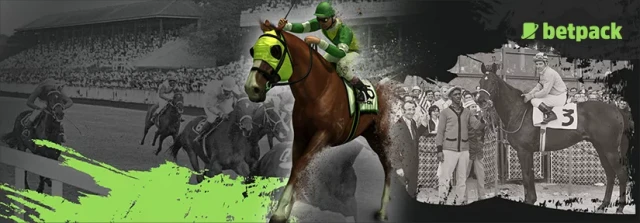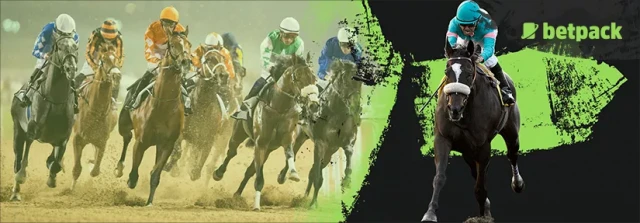- Betpack /
- Betting Guides /
- History Of Horse Racing
The Early Days of Horse Racing
Historical information offers different records of the origin of horse racing. Even though it is impossible to trace back to the first horse race, in some documents, horse racing dates as far back as 4500 BCE to Central Asia, where nomadic tribespeople first began the domestication of horses for various purposes.
Other records indicate the official date as 700-40 BCE, during the Olympic Games in Greece. Among the various early civilizations, the Roman Empire also engaged in horse racing as entertainment in public spaces.

Organized Horse Racing and the Rise of Thoroughbreds
Henry VIII enacted various rules concerning horse breeding and imported thousands of horses from other countries. The monarch established stables at Greenwich to train his horses and improve their endurance and pace. At this period, the first horse racing meetings were held.
King Charles II is recognized for setting up one of the earliest organized forms of horse racing in the form of the King's Plate races. Winners of these races earned prizes, and some of the rules implemented during the race still exist.
The period between 1702 – 1714 was great for horse racing. With Queen Anne on the throne, match racing developed into multi-horse races, and horse racing became a professional sport and not just a form of entertainment. A rapid surge in the number of racecourses around England provided a means for horse racing to grow into a profitable venture.
To act as the governing authority and regulate the horse racing events, the Jockey Club was created in 1750. This is the body responsible for getting racecourses to hold meetings and developing racing rules.
The actions of the Jockey Club had a significant impact on the rise of Thoroughbreds through its regulation of racehorse breeding. The Thoroughbreds are descendants of horses listed in the General Stud Book. The General Stud Book is an outcome of research by James Weatherby, an accountant for members of the Jockey Club in 1791.
The Thoroughbreds and Standardbreds
There are common breeds of horses such as the Thoroughbreds and Standardbreds which are considered the highest quality race horse breeds. The Thoroughbreds are unique breeds of horses that are suitable for racing and jumping. These horses were originally bred in England.
The Standardbreds are horses developed for harness racing in the United States. The Standardbreds are descendants of Messenger, an English Thoroughbred who is the original sire of this breed.
The creation of the Thoroughbreds and Standardbreds is an outcome of the need to eliminate the flaws in certain horse breeds. By crossing the bloodlines of different horse breeds, it is possible to get a mix of the qualities of different breeds in an offspring. Thoroughbred horse racing is a particularly popular sport in the US and the UK.
What is Live Cover in Horse Breeding?
The live cover implies that there are witnesses to the natural mating of a stallion and mare to produce a foal. A foal born of natural mating can be classified as a Thoroughbred only if there is a live cover.
To control the population of Thoroughbreds, there is a ban on the use of embryo transfer and artificial insemination for this breed.
Types of Horse Races
There are several types of races you can find at our full list of UK online bookmakers, and understanding each type of horse racing is crucial for anyone interested in betting on the races. Some races are for leisure while others are excellent for festivals and events.
Flat Racing
Flat racing is a type of horse race that takes place on a levelled, flat surface. Some flat racing events, such as the Dubai World Cup night take place on tracks, while others take place on turf.
The Thoroughbred horses are the common choice for the flat races, and these horses can cover one or more miles during these races.
Harness Racing
A harness race is a type of horse racing that involves horses pulling a sulky on which the driver stays mounted. In a harness race, the horse needs to complete the race at a specific pace or trot while pulling the sulky along.
The Prix d'Amerique is a popular harness race that takes place every year. During harness races, if a horse breaks its stride, the race officials may decide to disqualify the horse, penalize it, or slow it down.
Unlike the flat races, harness races require Standardbred horses.
Endurance Racing
An endurance race tests the endurance of horses. The race may occur over a long period or a longer track. Unlike most other types of races, endurance races aren't very popular due to the long time they take to complete.
Endurance races are open to various breeds of horses if they have the endurance and stamina to keep up. A popular breed for its stamina and endurance is the Arabian horse, which makes them popular in this scene. Stretching over a 1,000-kilometer course, the Mongol Derby is the longest endurance race available.
Jump Racing
Horse racing that involves horses jumping over hurdles and avoiding other obstacles are jump races. There are two common types of jump races: the Hurdles races and the Steeplechase races.
The Steeplechase horse racing is one of the earliest horse racing forms involving horses running across an open field while avoiding ditches and deep gullies on the field.
On the other hand, the hurdle races feature hurdles which are the obstacles that horses must leap over. The hurdles can be a combination of water, open ditches, and fences on the track.
Other popular types of races include:
- Claiming Race
- Allowance Race
- Stakes Horse Race
- Maiden Race
- Quarter Horse Race
National Hunt racing is the most popular jump racing event for English racing.

Horse Racing Today
The various races today result from the modern race era, which began from the St. Leger classic races in 1776. Other races in the early history of the modern era include the Oaks and Derby races. Over the years, more races like the Two Thousand Guineas, One Thousand Guineas, Grand Prix du Paris, Prix du Jockey Club, Belmont Stakes, Kentucky Derby, and many more were added.
Since the start of the modern era of horse racing, there have been developments in various aspects of horse racing, and you will learn about most of these developments as you read on.
Racing Strategies
Like many other sports, changes and advancements in the quality of horses and the design of racecourses pushed jockeys to come up with unique strategies to gain the upper hand when racing. For straight quarter-mile sprints, Thoroughbreds excel since they can run at top speed for this distance.
However, as racetracks with elliptical designs and longer distances began to show up, there was a need for jockeys to come up with racing strategies. Many jockeys had to consider a few factors on these tracks: when to run at top speed and the pace to set for the rest of the race. The American Seat, which is a worldwide posture in horseracing, is one of the strategies developed for short-distance races by American jockeys.
Racing Procedures and Race Judgements
There are several procedures that officials at racing events or festivals perform before a race. Here are some of the procedures that are common in races today:
- Eligibility checks on racers the day before the race.
- Weigh out of jockeys.
- A parade of riders and race horses to the post of race officials. When horses and riders arrive, there is a warm-up gallop and inspection by officials.
- Horses are moved to their stalls before the start of a race.
- Motion-picture patrol to capture racing violations.
- The use of a special camera to photograph the finish of the race. The image is essential for determining the winners in close races.
- Weigh-in of jockeys and certification of proper weight for riders.
- Urine tests of winning horses after the race.
- Assessment to determine the presence of banned substances on the field.
These are some of the common procedures for a horse race, and there are other procedures that the race officials may also perform before and after every race.
Horse Training
Like humans, training is vital for racehorses. There are several factors to consider to determine the best form of training for a racehorse. These include:
- Understanding of the horse
- Feeding program
- Suitable exercises
You should understand that the trainer isn't the same as a jockey. In horse racing, the trainer gets to pick the jockey for a horse. Other tasks the trainer must excel at include getting the horse to peak condition on a specific day and selecting the right race to enter the horse.
Advances in Technology
Compared to the early days of horse racing, most of the regulations, traditions, and rules remain the same. Nonetheless, certain aspects of horse racing have benefitted from technological advances.
Sports betting in the modern world is a lucrative industry with millions of customers. Previously, horse betting used to occur at the race tracks, but nowadays, bettors can place bets through their computers or mobile devices. Mobile devices and computers give players the options to make electronic payments and get digital versions of their betting slips.
Another area where technology has improved horse racing is horse and race safety. The use of X-rays, endoscopes, MRI scanners, and thermal imaging cameras can assist inntifying issues with a horse, such as overheating after a race. It is also possible to produce prosthetics, casts, and splints to treat injured horses.
Racing Silks
The racing silk is an essential aspect of horse racing. Its use dates to the 18th century, during which they served as a unique marker for spectators tontify different horses. Today, racing silks have an aesthetic purpose in horse races.
Despite its use for aesthetics, regulatory boards still require horse owners to register their colours and unique pattern.

Betting in Modern Horse Racing
A significant reason horse racing is still a popular sport is the betting aspect. For many years, betting has been a part of horse racing. Betting in horse racing gives individuals a chance to predict the outcome of a race and stake a certain amount for an opportunity to earn returns.
When placing bets on horse racing, you can do this in-person or online. In-person bets are common among players who visit the tracks to watch the race. Other bettors that don't have the opportunity to head to the tracks can place their bets online.
There are several types of horse racing bets, and we look at some of these betting types below:
Standard Bets
These are the common, classic types of bets in horse racing betting. There are three standard bets that bettors place, and they include the following:
- Win Bet: This is a type of bet in which you select the horse that will win the race. For you to get a payout, the horse you pick must win the race.
- Place Bet: This type of bet lets you select a horse that will come first or second. Bettors benefit from this type of bet since it protects them from a photo finish that may cause the selection to drop to second place.
- Show Bet: Although the payout for this type of bet is usually smaller than the Win or Place bet, a show bet allows you to pick a horse and get a payout if the selection comes in first, second, or third place.
Exotic Bets
The exotic bets give bettors a chance to pick two or more horses. These horses may be a selection from a single race (single-race exotics) or multiple races (multi-race exotics). Common examples of single-race exotic bets include the following:
- Exacta Bet: Here, you must select the top two finishing horses in the right order.
- Quinella: This bet gives you the option to select the top two finishing horses, and they can cross the line in any order.
- Trifecta: If you feel you're good enough, then the trifecta gives you a chance to pick the top three finishing horses in the right order.
For the Multi-race exotics, some of the common bets include:
- Double
- Pick 3
- Pick 4
- Pick 5
- Pick 6
Our accumulator calculator may help you to keep track of your exotic bets effortlessly.
Where can I find information on my Thoroughbred?
Is there a way to know the breeder?
How do you use the tattoo number of a horse?
How To Bet On Sports
How To Bet On Basketball
How To Bet On Football
How To Bet On Esports
How to Bet On Golf
How to Bet On Ice Hockey
How to Bet On Volleyball
How to Bet On Horse Racing
How to Bet On Handball
How to Bet On Boxing
How to Bet On Tennis
How to Bet On Rugby
How to Bet On American Football
How to Bet On Snooker
How to Bet on Sports Successfully



